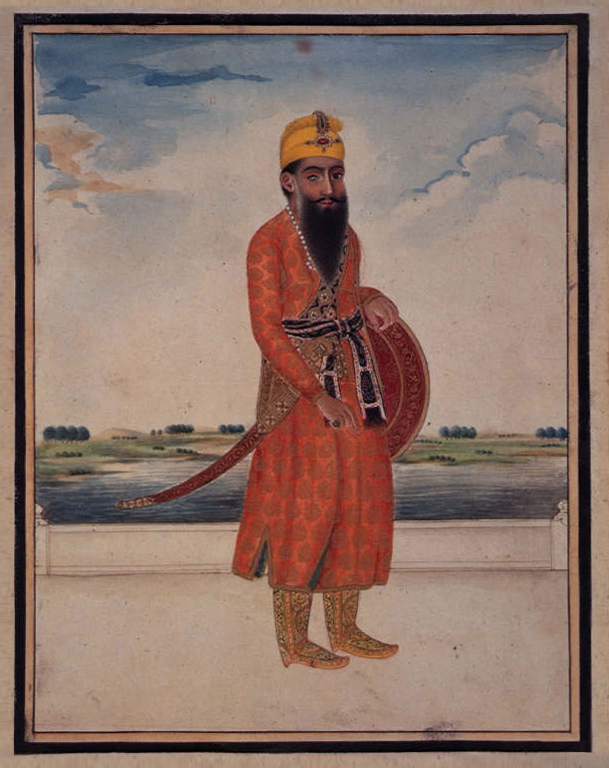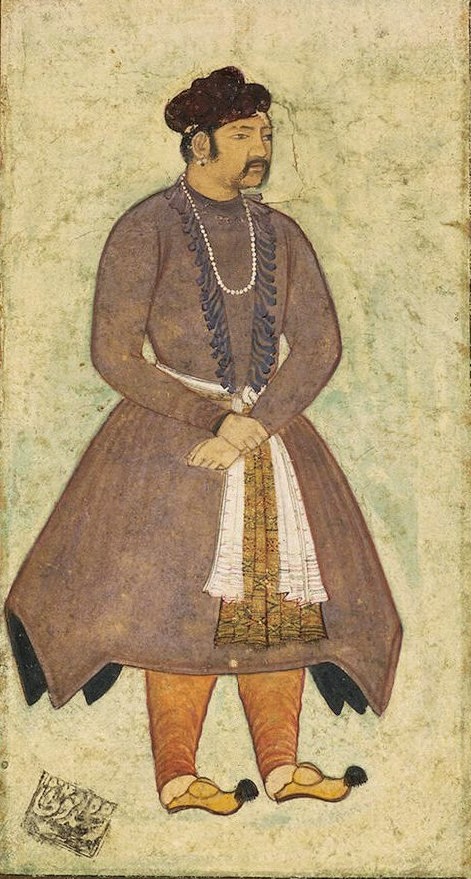|
Farzi (coat)
''Farzi'' refers to an outer garment of the Mughal court. It was a coat with short sleeves and fur collars, opened in front. The length was shorter than Jama. Farzi was a winter's garment. Mughal emperors and courtiers were wearing it over the Jama, fastened with a decorated piece of cloth, i.e., Katzeb ''Katzeb'' (''kamarband, Kayabandh, Cummerbund'') was an article of dress encircling the body, at the waist with ends hanging in the front. It was a kind of sash also called ''Patka''. Name ''Katzeb'' is a compound word. The Sanskrit word ''Kat ... around the waist area with loosely hanging ends. Farzi was one of the costumes given in ''Khilat'' (robes of honour) to the Mughal nobles and other courtiers. The coat was very much famous in the 17th century among the royals. See also * Mughal clothing * Tubada References Mughal clothing {{Clothing-stub ... [...More Info...] [...Related Items...] OR: [Wikipedia] [Google] [Baidu] |
Costume Of India - Moguls
Costume is the distinctive style of dress or cosmetic of an individual or group that reflects class, gender, profession, ethnicity, nationality, activity or epoch. In short costume is a cultural visual of the people. The term also was traditionally used to describe typical appropriate clothing for certain activities, such as riding costume, swimming costume, dance costume, and evening costume. Appropriate and acceptable costume is subject to changes in fashion and local cultural norms. This general usage has gradually been replaced by the terms "dress", "attire", "robes" or "wear" and usage of "costume" has become more limited to unusual or out-of-date clothing and to attire intended to evoke a change in identity, such as theatrical, Halloween, and mascot costumes. Before the advent of ready-to-wear apparel, clothing was made by hand. When made for commercial sale it was made, as late as the beginning of the 20th century, by "costumiers", often women who ran businesses that ... [...More Info...] [...Related Items...] OR: [Wikipedia] [Google] [Baidu] |
Mughal Empire
The Mughal Empire was an early-modern empire that controlled much of South Asia between the 16th and 19th centuries. Quote: "Although the first two Timurid emperors and many of their noblemen were recent migrants to the subcontinent, the dynasty and the empire itself became indisputably Indian. The interests and futures of all concerned were in India, not in ancestral homelands in the Middle East or Central Asia. Furthermore, the Mughal empire emerged from the Indian historical experience. It was the end product of a millennium of Muslim conquest, colonization, and state-building in the Indian subcontinent." For some two hundred years, the empire stretched from the outer fringes of the Indus river basin in the west, northern Afghanistan in the northwest, and Kashmir in the north, to the highlands of present-day Assam and Bangladesh in the east, and the uplands of the Deccan Plateau in South India. Quote: "The realm so defined and governed was a vast territory of some , ra ... [...More Info...] [...Related Items...] OR: [Wikipedia] [Google] [Baidu] |
Jama (coat)
The term jama ( Hindustani: जामा, جام ; Bengali: জামা; Odia: ଜାମା ) refers to a long coat which was popular in South Asia during the Mughal period. Styles ]Some styles of the jama were tight around the torso but flared out like a skirt to below the knees or the ankles. * The chakman jama, ended at around the knees. The sleeves tended to be full. The jama was fastened to either side with strings with some styles also opening at the front. What was originally male dress was also adopted by women who wore the jama with a scarf and tight fitting pajamas. The ties of the upper half of the jama are taken under the armpit and across the chest. * ''Chakdar jama'' Jama with chaks (slits) was a particular style of jama. It was the pointed jama which was like the standard Mughal jama but the skirt fell in four to six points instead of the circular hem of the Mughal jama. This jama may be derived from the Rajput court's takauchiah and therefore could be of local ... [...More Info...] [...Related Items...] OR: [Wikipedia] [Google] [Baidu] |
Mughal Emperors
The Mughal emperors ( fa, , Pādishāhān) were the supreme heads of state of the Mughal Empire on the Indian subcontinent, mainly corresponding to the modern countries of India, Pakistan, Afghanistan and Bangladesh. The Mughal rulers styled themselves as " padishah", a title usually translated from Persian as "emperor". They began to rule parts of India from 1526, and by 1707 ruled most of the sub-continent. After that they declined rapidly, but nominally ruled territories until the Indian Rebellion of 1857. The Mughals were a branch of the Timurid dynasty of Turco-Mongol origin from Central Asia. Their founder Babur, a Timurid prince from the Fergana Valley (modern-day Uzbekistan), was a direct descendant of Timur (generally known in western nations as Tamerlane) and also affiliated with Genghis Khan through Timur's marriage to a Genghisid princess. Many of the later Mughal emperors had significant Indian Rajput and Persian ancestry through marriage alliances as emp ... [...More Info...] [...Related Items...] OR: [Wikipedia] [Google] [Baidu] |
Katzeb
''Katzeb'' (''kamarband, Kayabandh, Cummerbund'') was an article of dress encircling the body, at the waist with ends hanging in the front. It was a kind of sash also called ''Patka''. Name ''Katzeb'' is a compound word. The Sanskrit word ''Kati'' means waist, and ''Zeb'' in Persian means adorn. Mughals wore it over the Jama (coat). The Katzeb is a girdle named by the third Mughal emperor Akbar who was very fashion enthusiastic and gave a new name to many contemporary costumes. These are described in Ain-i-Akbari by Abu'l-Fazl ibn Mubarak. Court costume ''Katzeb'' was a small rectangular piece of cloth but it was an essential garment of the dress that includes a jama (a coat), shawl, turban ''tanzeb (trouser)''. There are many Mughal paintings of the emperors with a sword or dagger tucked in ''Katzeb.'' Styles The katzeb is simple cloth belt like garment possible with many variants such as plain, laced, embroidered, brocaded or printed. See also *Jama (coat) The ter ... [...More Info...] [...Related Items...] OR: [Wikipedia] [Google] [Baidu] |
Mughal Clothing
Mughal clothing refers to clothing developed by the Mughals in the 16th, 17th and 18th centuries throughout the extent of their empire in the Indian subcontinent. It was characterized by luxurious styles and was made with muslin, silk, velvet and brocade. Elaborate patterns including dots, checks, and waves were used with colors from various dyes including cochineal, sulfate of iron, sulfate of copper and sulfate of antimony were used. Men traditionally wore long over-lapping coat known as Jama with patka sash tied around on the waist and " "Paijama" style pants were worn (leg coverings that gave the English word pajama) under the Jama. A "pagri" (turban) was worn on the head to complete the outfit. Women wore "shalwar", churidar", "dhilja", "gharara", and " farshi". They wore much jewelry including earrings, nose jewelry, necklaces, bangles, belts, and anklets. Other clothing types included: " peshwaz" style robes and "yalek" robes. Pagri styles included: " Chau-goshia", in four ... [...More Info...] [...Related Items...] OR: [Wikipedia] [Google] [Baidu] |
Tubada (coat)
Tubada was an outer garment for men in India. It was a coat, part of a Hindu's costume in the early 19th century. John Forbes Watson mentions it as a ''wide great coat'' in his book ''The Textile Manufactures and the Costumes of the People of India'', London, 1866. See also * Achkan * Jama (coat) * Mujib coat * Nehru jacket The Nehru jacket is a hip-length tailored coat for men or women, with a mandarin collar, and with its front modelled on the Indian achkan or sherwani, a garment worn by Jawaharlal Nehru, the prime minister of India from 1947 to 1964. Hist ... References History of clothing Indian clothing {{Clothing-hist-stub ... [...More Info...] [...Related Items...] OR: [Wikipedia] [Google] [Baidu] |





